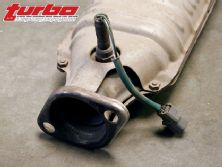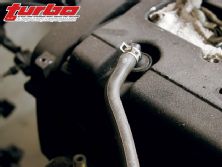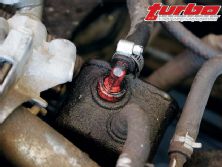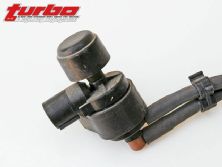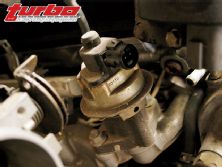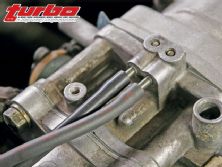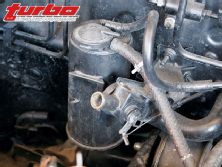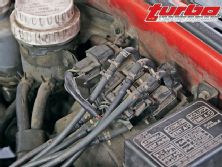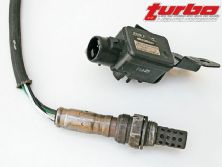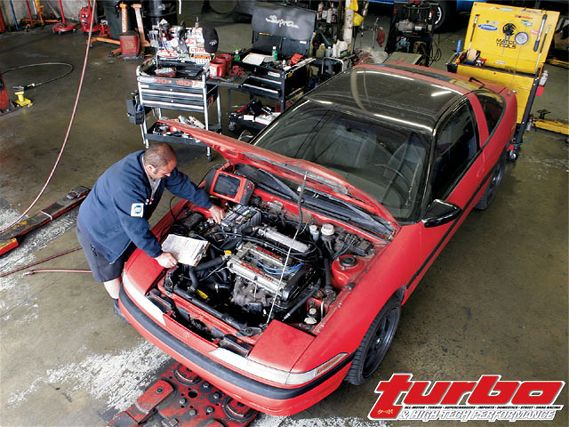 | Emission Components - Clearing The Air
| Emission Components - Clearing The Air
Unless you chuck Taco Bell bags out your window onto the freeway shoulder daily or dump buckets of coolant in your neighbor's bushes, just driving your car alone is probably the single most polluting act you do on a regular basis. That is, unless you eat Taco Bell everyday but that's another kind of pollution. According to the Environmental Protection Agency, cars are the biggest contributor when it comes to ground-level ozone, the No. 1 air pollution problem in much of the United States. Cars also give off pollutants - toxins - that are responsible for about 1,500 cancer cases in the U.S. each year. And then there's also acid rain, global warming and lots of other bad things. But cars with internal combustion engines aren't going anywhere. At least not anytime soon.
There are three bad things we can blame on the internal combustion engine: hydrocarbons, nitrogen oxides and carbon monoxide. And there are three ways this crap can get into the atmosphere: through tailpipe emissions, underhood evaporative emissions and refueling emissions. Since the 1970s, automakers have fitted cars with various components designed to lessen the environmental impacts caused by vehicle emissions. Every few years or so, these components become more complex and in turn do a better job. If you live somewhere like California and you're reading this magazine, chances are you're eerily familiar with the state's stringent emissions laws. Most enthusiasts would prefer getting their wisdom teeth pulled than to visit their local Test-Only center for their biennial smog checkup. If you live in some Midwest state where you don't even have to get a smog check, wipe that grin off your face because we're not laughing. But things don't have to be this way. The number of emissions-legal aftermarket components is growing, as is the number of aftermarket parts that remain compatible with OEM-issued emissions components. And that's a good thing. Ripping off emissions components in the name of high-performance isn't just bad for the environment, it can also cause today's modern day engines to actually run worse. Here's a rundown of a typical vehicle's emissions components, what they do, and why you need to leave them alone.
CATALYTIC CONVERTER:The catalytic converter is probably the most notorious of all auto emissions reducing components. The cat is integrated into the vehicle's exhaust stream, just after the manifold and before the muffler. Catalytic converters work best when hot, that's why many OEMs have integrated cats into exhaust manifolds, as close to the combustion process as possible. Most cars on the road today are equipped with three-way cats. That means they help chemically reduce three things: hydrocarbons, nitrogen oxides and carbon monoxide. There are two stages to the modern-day, honeycomb-type or pellet-type cats. The reduction stage is the first and it uses platinum and rhodium coated honeycomb or pellets to reduce nitrogen oxides. As exhaust gases pass through, nitrogen oxides contact the metal-coated ceramic structure and oxygen atoms are separated from nitrogen atoms allowing the formation of harmless oxygen and nitrogen. The oxidation stage makes use of the oxygen just produced to burn the hydrocarbons and carbon monoxide over a palladium and platinum catalyst leaving nothing more than carbon dioxide and water.
There has to be oxygen here for this stage to work, so some cats use a sort of air pump to direct oxygen into the process; others are just embedded with the element cerium, which chemically stores oxygen. This is more common today. Cerium stores oxygen during lean conditions and emits it during rich ones. This is important because for a cat to work right, it has to be able to deal with both rich and lean conditions. A rich exhaust is necessary for reducing nitrogen oxides, but you can't oxidize hydrocarbons and carbon monoxide unless things are lean - that's why it's good to get a cat as hot as possible prior to an emissions test. There's no denying the fact that catalytic converters prohibit optimal exhaust flow. This is especially a problem on turbocharged vehicles with performance that hinges on exhaust volume. There are many aftermarket cats offered that flow almost as well as eliminating the cat altogether - almost. Before removing a cat in lieu of a straight pipe and risk a hefty fine though, it'd be wise to look into a high-flow aftermarket unit first. If not for the sake of our clean air, do it for your wallet; no-cat fines can easily reach two grand in states like California.
PCV Valve:As piston rings inevitably wear, gases formed in the combustion chamber make their way into the crankcase - where you keep your rods and crankshaft. For the engine to function properly, these gases have to go somewhere else. If you look at the small block under the hood of your grandpa's old truck, you'll likely find one or two vent tubes exiting the block. This gets the job done at the expense of a bit of pollution. Newer cars use PCV (positive crankcase ventilation) valves to reduce these under-hood evaporative emissions. PCV valves are one-way check valves that use manifold vacuum to suck the junk out of the crankcase and into the manifold for reentry into the combustion chamber. To keep the engine from imploding, a fresh air source is also plumbed into the crankcase usually taken from the intake stream. But when blow-by gets out of hand, gases and oil can flow the wrong way, up the intake hose and into the intake stream and air filter. This signals either a damaged PCV valve or failed piston oil rings. Typically, an engine will benefit little, performance-wise, from eliminating the PCV system and running an external breather tank. Cases where it might marginally improve performance include high-compression, naturally aspirated engines that use low-tension oil rings or engines that exhibit poor ring sealing and a lot of blow-by in the first place. In both of these situations a significant amount of oil will inevitably enter the combustion chamber, effectively lowering the octane and increasing the chances of detonation. Turbocharged and supercharged applications can be even worse but because of a different reason. When an engine produces positive pressure in the intake manifold and positive pressure in the crankcase, blow-by is forced backwards into the intake stream - not the combustion chamber. In this case, it's not doing its job anymore, and with the added crankcase pressure, the potential for blown seals and oil leaks increases. Engines like these will benefit from some other type of crankcase ventilation system, like your grandpa's truck. But generally you'll find little or no horsepower gains from removing the PCV system on a normal vehicle, and besides, it's illegal - even if you live in the Midwest.
EGR Valve:Like the catalytic converter, an engine's EGR (exhaust gas recirculation) system is designed to reduce nitrogen oxides. It does this by recirculating a small portion (5-10 percent) of the engine's exhaust gases back into the intake stream and combustion chamber. In theory, the EGR system might sound like a bad thing at first, diluting the intake charge with hot, crappy exhaust gases. But it's not. In fact, by diluting the intake charge with chemically inactive exhaust gases, combustion temperatures are actually lowered. The inert gases don't actually do anything once inside the combustion chamber but occupy space. They can't since they're inert. Lowered combustion temperatures are better for performance and they also help reduce nitrogen oxides. A win-win, for the EPA and for you. The less heat that's given off to the cylinder head, valves and pistons through thermal transfer, the more can be used for mechanical power production. Vehicles that don't use EGR valves accomplish this same end result but in a different way - through valve overlap. Many Honda engines, for example, use intake and exhaust valve overlap to trap exhaust gases in the combustion chamber, just like the EGR does. Contrary to popular belief, removing an EGR valve will actually hurt performance. It's tempting to get rid of this stuff since an EGR's vacuum connections are often the source of boost related woes, but a properly functioning EGR will help reduce knock-induced detonation through cooler combustion temperatures. EGR systems are fed either internally, through a port in the cylinder head, or externally, via a tube exiting the exhaust manifold. Either way, gases are transferred to the vacuum assisted valve that opens and closes according to engine load. Modern EGR valves are ECM-controlled, which means the vehicle's computer tells it when to open and close via a solenoid.
EVAP System:The tailpipe isn't the only place vehicle emissions can come from. Underhood gasoline vapors are just as harmful and there's a whole system designed to alleviate just that - it's called the evaporative emission control system, or EVAP. EVAP systems trap and hold gasoline vapors through a series of components. They use what's called a charcoal canister to trap the gas fumes from the tank. These canisters really do consist of charcoal since charcoal (carbon granules) is one element that can attract gasoline vapors (also carbon based). In other words, carbon attracts carbon. But the fumes don't stay in the canister; manifold vacuum draws them back out and, like the EGR system, sends them to the combustion chamber and into the catalytic converter for cleansing. A vacuum valve or computer-controlled solenoid dictates how much and when this all happens. OBDII vehicles take the EVAP process a few steps further with the addition of an EVAP system monitor that constantly tests for purge volume and leaks. In these systems the vehicle's ECM controls when and for how long the system purges. A typical purge system only works at idle and under part throttle so such systems affect wide-open throttle performance little.
It's tempting to get rid of the smog stuff. PCV valves, emissions vacuum lines and EGR valves can often complicate the power-making process and, frankly, things like a nice looking charcoal canister won't contribute to your trophy at the next car show. But there's really no reason to get rid of this stuff. Take Turbo's Project Integra for example: we're pushing close to 300 flywheel horsepower with our emissions legal Edelbrock turbo kit and completely un-tampered emissions system. Low emissions and high performance might not ever go hand in hand, but there's no longer an excuse for them not to be able to at least coexist.

